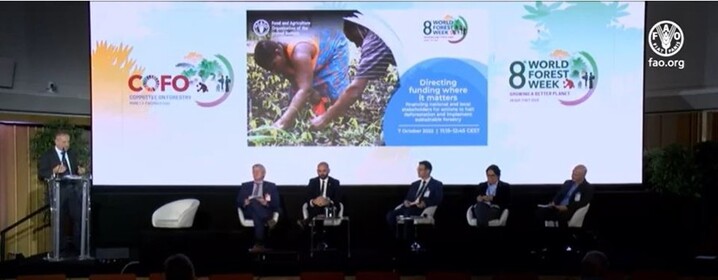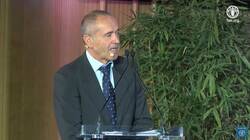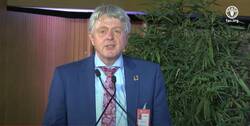Delivering higher quality investment to small-scale forest and farm producers

Rome, 7 October 2022 - There is evidence that forests managed by Indigenous Peoples and local communities (IPLC) are extensive, highly biodiverse, exhibit low deforestation and support food security. IPLC and forest and farm smallholders are the key to building climate resilient landscapes but they receive less than two percent of climate finance and are constantly overlooked for major climate projects.
Representatives of Indigenous Peoples groups, investment banks, global funding bodies and government agriculture departments shared strategies, models, and successful approaches to overcome these challenges at a special event titled “Directing funding where it matters” held on the margins of the 26th Session of the Committee on Forestry (COFO26) at UN Food and Agriculture Organization (FAO) headquarters in Rome.
The audience at the event jointly organised by FAO and the Forest and Farm Facility (FFF) heard that even though they are the lynchpins of forest value chains, investors often perceive smallholder farmers and forest producers as risky prospects for climate finance projects, carrying additional costs and risks, because of a lack of collateral, for example.
Their small scale and the high transaction costs due to value chain fragmentation are also barriers to investment.

The informal nature of their organisations, the fact that they often have no legal status, and limited business and financial literacy was cited as a restraint as well.
However, some emerging opportunities exist as businesses and investors are both committed to sustainability and want to be part of the solution.
“Equitable integration of smallholders in forest-based value chains (with fair distribution of benefits, costs, and risks) can be a win-win solution for both larger businesses interested in sustainability and local producers,” said FAO Forestry Officer and event moderator, Marco Boscolo.
Financing local, sustainable and inclusive forestry models
Forest and farm producers are investing their land, labour and enterprises and are implementing more and more sustainable practices, through seed diversification, agro ecology practices, tree planting, sustainable charcoal production, and timber products certifications.
To transition agrifood systems towards a more sustainable future, the recognition of IPLC forest tenure rights and an increase of accessible local-level finance to small-scale producers is essential. Enabling investments are also needed to reach scale and attract external investors.
Duncan Macqueen, International Institute for Environment and Development (IIED) Team Leader- Forests, explained, “Forest and farm producer organizations (FFPOs) need investment that enables them to build organizational skills, to secure their land, and support their business development. They need business partners who are patient and want to help them secure long-term sources of products. They need enabling investment that does not expect immediate financial returns.”
The FFF (a partnership between FAO, IIED, IUCN and AgriCord) is working to help FFPOs and regional indigenous groups to organise, strengthening their capacity to receive climate funds. It provides training, linkages with private sectors, roundtables with stakeholders, and works with governments to obtain recognition of the role of the organizations. It builds the technical and administrative capacity of existing funds receiving finance and supports donors to monitor allocations of funding.
Successful local models in place
Some grassroots organizations in the sector are entering the climate finance business themselves. “In terms of finance mechanisms, some have developed their own village savings loans,” Macqueen said. “Some more organised ones have created credit unions.”
Gustavo Sanchez, President of the Executive Council of the Measoamerican Alliance of Peoples and Forests (AMPB) described the experiences of his organisation, one of the territorial funds incubated by the FFF. After several years of investing in its local capacities, AMPB began piloting their own climate finance model, the Mesoamerican Territorial Fund (FTM), aimed at getting finance directly to local people. “We are funding 12 projects across our region, including in Guatemala and Mexico. Direct territorial investment lowers the cost of intermediaries and ensures that local communities and their organizations define the investment priorities,” said Sanchez.
Steps forward
The event highlighted that gaps still exist in knowledge and understanding between institutional investors, banks and small-scale producers.
“FAO is building the capacities of smallholders and their organizations to develop bankable forest-based businesses,” said Boscolo. “It is helping countries access funds of financial institutions and that’s not all. It’s also developing geospatial tools to identify areas where restoration can be linked to the development of value chains with engagement of local stakeholders.”

Chief Advisor of the Netherlands Ministry of Agriculture, Nature and Food Quality Rob Busink suggested governments step in to bridge the gap, forming creative partnerships with private banks and FFPOs: “Important steps need to be made on both sides,” he told the event audience. “A concrete example would be to identify a mechanism to support FFPOs with their first loan in order to create their own bankable history “track record”, which would lower enormously that first stepping-stone for both sides.”
